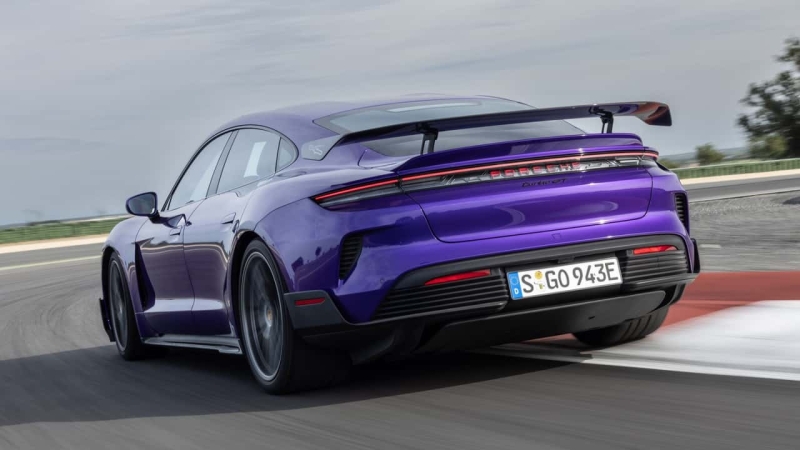We lapped Porsche’s 1,000-plus-horsepower EV. It’s a friendly beast.
I’m too narrow into Circuto Monteblanco’s turn two. Lars Kern, Porsche’s factory development-driver ace in the car leading me around the track, pulls away. No matter, though. Tug at the Porsche Taycan Turbo GT’s right-hand steering-wheel paddle and you unlock Attack Mode, which gives you 1,019 horsepower for 10 seconds. Get on throttle quickly, and the car scrambles out of the corner with authority, vaporizing my mistake.
It’s a monster.
| Quick Specs | 2025 Porsche Taycan Turbo GT Weissach Package |
| Motor | Dual Permanent-Magnet Synchronous |
| Battery | 93.4-Kilowatt-Hour Lithium-Ion |
| Output | 1,019 Horsepower / 958 Pound-Feet |
| 0-60 MPH | 2.1 Seconds |
| Curb Weight | 4,850 Pounds |
| Base Price | $231,995 |
The Turbo GT is the product of “what if?” Specifically, “What if we made a track car out of an electric sedan?” A genuine skunkworks project, a small team within Porsche developed the car. The team answered only to the board, not middle management. The quickest four-door in the world—electric or not—resulted.
We turned a handful of laps at Circuito Monteblanco outside Seville, Spain, on the launch for the recently facelifted Taycan. It was eye opening.
Based on the Turbo S, the Turbo GT gets a new silicon-carbide inverter for the rear motor that pushes total power output up to 1,019 hp during launch control and for 10 seconds in what Porsche calls “Attack Mode,” and in all other situations, you get 777 hp.
That power pairs to revised aerodynamics including a fixed rear wing on the Turbo GT model, wider wheels and tires, a specific tune for the standard active-suspension system, and some weight-savings measures. Nothing too extreme, well maybe except for the rear-seat delete with the Weissach Package. Even the power figure, though enormous, isn’t that much greater than the Turbo S’s. But these tweaks adds up to a very different electric sport sedan.
Even knowing chassis electronics have made ultra-high-horsepower cars so approachable, the Taycan Turbo GT intimidates. It’s still a 1,000-plus-horsepower car that weighs close to 5,000 pounds in its lightest form. I didn’t pay much attention in physics, but I do know that force is equal to mass times acceleration, and this has a lot of M and A.
Yet, the Turbo GT is shockingly approachable. For something designed to set crazy fast lap times, it’s incredibly welcoming and talkative. You quickly get a sense of the grip level available, which is gargantuan. The Turbo GT comes with the new Pirelli P-Zero R tires standard, and while these tires manage the huge power and weight well, the optional Trofeo RS really make the car come alive. Turn-in grip is absurd. You turn the wheel and think you’re at the limit, but there’s always more available. And breathe off the throttle mid corner and the car rotates beautifully. It’s so responsive.
On either tire, the Turbo GT feels hundreds, if not a thousand pounds lighter than it is. The standard Porsche Active Ride suspension system is fully active, meaning it can put force into the body via hydraulic motor-pump units connected to each damper. The system runs off the Taycan’s 800-volt battery and is capable of generating enormous force (2,248 pounds) in a very short amount of time. As a result, the Turbo GT has virtually no roll, pitch, or dive. (It doesn’t compensate for tire deflection, so the car does move around, but the body sits perfectly level.)
Gallery: 2025 Porsche Taycan Turbo GT First Drive
Clever calibration means this feels more natural than you’d expect, but Active Ride generates immense grip by controlling the loads independently at each corner. The damping is basically perfect, too. Monteblanco has a couple tall curbs and big rumble strips. You can huck a Turbo GT over them at silly speeds and the car just shrugs it off.
If a car is just a battle between horsepower and grip, this battle is evenly matched. Which is astonishing. In the slow corners and chicanes, the Turbo GT rockets forward, with just a hint of how hard the car is working to generate traction; in the high-speed stuff, it feels absolutely stable. Between the massive mechanical and aero grip—the Turbo GT Weissach Package generates a maximum of 485 lbs at its 190-mph top speed—the car feels planted at all times.
Monteblanco’s best corner is a fast uphill right with a compression at the bottom. You need a light brake or a lift, and the corner puts so much load through the car. The Turbo GT takes it all no problem. It’s astonishing.
The Turbo GT excels at stopping too, especially when you consider the fact that it’s constantly adjusting the balance of regenerative and friction braking, and dealing with incredible speed and weight.
Oh yeah, speed. Porsche had us stop along the front straight and launch the Turbo GT. From there, Kern says if you ran the full length of the straight, you’d probably be doing around 175 mph braking into turn one. Too fast for an event like this. Yet even stopping more than halfway down the straight and using launch control, you still hit around 120 mph before you have to pull the chute.
Launching the Turbo GT is genuinely disorienting. Porsche says 0-60 mph in 2.1 seconds for the Weissach Pack car, and the first time I did it, my vision went blurry for an alarming amount of time. It takes a little over six seconds to get to 124 mph, which is about as long as it’d take me to get to 60 in my Volkswagen GTI if I decided that I no longer wanted a functioning clutch.
The acceleration and speed are party tricks, but the Turbo GT is much more. It feels entirely at home on a track. The way it generates grip recalls the best stuff I’ve ever driven on a circuit, and it still manages to feel engaging.
“For us as race car drivers, it’s not a negative if the car drives well,” Kern says. “It’s as easy as that. We like a comfortable car as well, a car that’s easy to drive at the limit.”
Downsides? The cool bucket seats you see here aren’t available in America. They’re a little silly in a car like this, but they offer more feedback through the seat of the pants, and, well, the whole car is a little silly, right?
I think the target audience for this is small, though. A $230,000 four-door EV track car is a very specific niche, but I suppose there are always people who want the best version of a thing. And while we didn’t get to drive the Turbo GT on the road, the flexibility of the active suspension should mean it’s no more difficult as an everyday proposition than any other Taycan. Unless you delete the rear seats.
Competitors
- Lucid Air Sapphire
- Tesla Model S Plaid
Get the Motor1 Newsletter Sign Up Today
2025 Porsche Taycan Turbo GT Weissach Package
Motor Dual Permanent-Magnet Synchronous
Battery 97-Kilowatt-Hour Lithium-Ion
Output 1,019 Horsepower / 958 Pound-Feet
Transmission Two-Speed Automatic For Rear Motor
Drive Type All-Wheel Drive
Speed 0-60 MPH 2.1 Seconds
Maximum speed 190 MPH
Weight 4,850 Pounds
EV Range TBD
Charge Time 18 Minutes 10-80% DC Fast Charging
Charge Type AC Charging Up to 9.6 kW / DC Fast Charging Up to 320 kW
Seating Capacity 2
On Sale Now
Base Price $230,000


